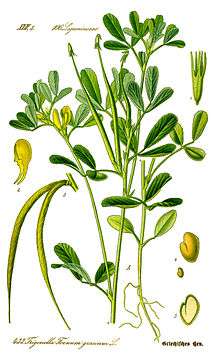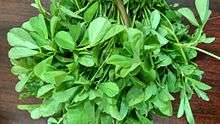Fenugreek
| Fenugreek | |
|---|---|
 | |
| Scientific classification | |
| Kingdom: | Plantae |
| (unranked): | Angiosperms |
| (unranked): | Eudicots |
| (unranked): | Rosids |
| Order: | Fabales |
| Family: | Fabaceae |
| Genus: | Trigonella |
| Species: | T. foenum-graecum |
| Binomial name | |
| Trigonella foenum-graecum L.[1] | |

Fenugreek (/ˈfɛnjᵿɡriːk/; Trigonella foenum-graecum) is an annual plant in the family Fabaceae, with leaves consisting of three small obovate to oblong leaflets. It is cultivated worldwide as a semiarid crop, and its seeds are a common ingredient in dishes from the Indian subcontinent.
History
Fenugreek is believed to have been brought into cultivation in the Near East. While Zohary and Hopf are uncertain which wild strain of the genus Trigonella gave rise to domesticated fenugreek, charred fenugreek seeds have been recovered from Tell Halal, Iraq, (carbon dated to 4000 BC) and Bronze Age levels of Lachish and desiccated seeds from the tomb of Tutankhamen.[2] Cato the Elder lists fenugreek with clover and vetch as crops grown to feed cattle.[3] In the 1st century CE, in Galilee, it was grown as a food staple, as Josephus mentions it in his book, the Wars of the Jews.[4] A compendium of Jewish oral law known as the Mishnah (compiled in the 2nd century) mentions the plant under its Hebrew name, tiltan.[5]
Production
Major fenugreek-producing countries are Afghanistan, Pakistan, India, Iran, Nepal, Bangladesh, Argentina, Egypt, France, Spain, Turkey, and Morocco. The largest producer is India, where the major producing states are Rajasthan, Gujarat, Uttarakhand, Uttar Pradesh, Madhya Pradesh, Maharashtra, Haryana, and Punjab. Rajasthan accounts for over 80% of India's output.[6]
Use
Fenugreek is used as an herb (dried or fresh leaves), spice (seeds), and vegetable (fresh leaves, sprouts, and microgreens). Sotolon is the chemical responsible for fenugreek's distinctive sweet smell. Cuboid-shaped, yellow- to amber-colored fenugreek seeds are frequently encountered in the cuisines of the Indian Subcontinent, used both whole and powdered in the preparation of pickles, vegetable dishes, daals, and spice mixes such as panch phoron and sambar powder. They are often roasted to reduce bitterness and enhance flavor.[7]
Fresh fenugreek leaves are an ingredient in some Indian curries. Sprouted seeds and microgreens are used in salads. When harvested as microgreens, fenugreek is known as samudra methi in Maharashtra, especially in and around Mumbai, where it is often grown near the sea in the sandy tracts, hence the name samudra, "ocean" in Sanskrit.[8] Samudra methi is also grown in dry river beds in the Gangetic plains. When sold as a vegetable in India, the young plants are harvested with their roots still attached and sold in small bundles in the markets and bazaars. Any remaining soil is washed off to extend their shelf life.
In Turkish cuisine, fenugreek is used for making a paste known as çemen. Cumin, black pepper, and other spices are added into it, especially to make pastırma.
In Persian cuisine, fenugreek leaves are called شنبلیله (shanbalile). They are the key ingredient and one of several greens incorporated into ghormeh sabzi and eshkeneh, often said to be the Iranian national dishes.
In Egyptian cuisine, peasants in Upper Egypt add fenugreek seeds and maize to their pita bread to produce aish merahrah, a staple of their diet.[9]
Fenugreek is used in Eritrean and Ethiopian cuisine.[10] The word for fenugreek in Amharic is abesh (or abish), and the seed is used in Ethiopia as a natural herbal medicine in the treatment of diabetes.[10]
Yemenite Jews following the interpretation of Rabbi Shelomo Yitzchak (Rashi), believe fenugreek, which they call hilbeh, hilba, helba, or halba (חילבה), to be the Talmudic rubia (רוביא). When the seed kernels are ground and mixed with water they greatly expand, to which hot spices, turmeric and lemon juice are added to produce a frothy relish eaten with a sop. The relish, like the seeds, is also called hilbeh,[11] reminiscent of curry. It is consumed daily and ceremonially during the meal of the first and/or second night of the Jewish New Year, Rosh Hashana.[12]
It is recommended by lactation advisers and used by breastfeeding mothers to help stimulate milk production and supply and it is also supposed to help either gain or reduce weight. However, there is not enough evidence to support these claims.[13]
Nutritional profile
| Nutritional value per 100 g (3.5 oz) | |
|---|---|
| Energy | 205 kJ (49 kcal) |
|
6 g | |
|
0.9 g | |
|
4.4 g | |
| Minerals | |
| Calcium |
(40%) 395 mg |
| Iron |
(15%) 1.93 mg |
| Phosphorus |
(7%) 51 mg |
| Other constituents | |
| Water | 88.7 g |
| |
| Percentages are roughly approximated using US recommendations for adults. | |
Fenugreek leaves contain these nutrients per 100 g of edible portion:[14][15]
- Carbohydrates: 6.0 g
- Protein: 4.4 g
- Fat: 0.9 g
- Calcium: 395 mg
- Phosphorus: 51 mg
- Iron: 1.93 mg
- Total energy: 49 kcal
Safety
Fenugreek sprouts, cultivated from contaminated seeds imported from Egypt in 2009 and 2010, were implicated but not definitively linked to the 2011 outbreak of Escherichia coli O104:H4 in Germany.[16]
References
- ↑ "Trigonella foenum-graecum information from NPGS/GRIN". www.ars-grin.gov. Retrieved 2008-03-13.
- ↑ Daniel Zohary and Maria Hopf (2000). Domestication of plants in the Old World (Third ed.). Oxford University Press. p. 122.
- ↑ Cato the Elder. De Agri Cultura. p. 27.
- ↑ Josephus, De Bello Judaico, book 3, chapter 7, vs. 29. The prepared relish made from ground fenugreek seeds is very slimy and slippery, and was therefore poured over ladders as a stratagem to prevent the enemy's ascent.
- ↑ Thus explained by Maimonides in his commentary on the Mishnah (Kilaim 2:5; Terumot 10:5; Orlah 3:6; Niddah 2:6, et. al), although not to be confused with the Modern Hebrew word, tiltan, which is now used for clover (Trifolium).
- ↑ V. A. Parthasarathy, K. Kandinnan and V. Srinivasan (ed.). "Fenugreek". Organic Spices. New India Publishing Agencies. p. 694.
- ↑ "Fenugreek recipes". BBC Food.
- ↑ "How to Series: Growing Methi (Fenugreek)". A blog called "Fenugreek Love". Retrieved 2 March 2011.
- ↑ "Aish Merahrah-Egyptian Fenugreek Corn Bread". The Taste of Aussie. Retrieved 29 June 2014.
- 1 2 Gall, Alevtina; Zerihun Shenkute (November 3, 2009). "Ethiopian Traditional and Herbal Medications and their Interactions with Conventional Drugs". EthnoMed. University of Washington. Retrieved January 27, 2011.
- ↑ "Hilba (Fenugreek_paste)". cookipedia.co.uk.
- ↑ This is based on the assumption that the Aramaic name רוביא corresponds to it. (Karetot 6a; Horiyot 12a) Rabbenu Nissim at the end of Rosh Hashana, citing the custom of R Hai Gaon. This follows Rashi's translation of רוביא, cited as authoritative by Tur and Shulchan Aruch OC 583:1. But Abudirham interprets רוביא as black-eyed peas.
- ↑ "Proceed with Caution: Fenugreek and Breastfeeding". Mothers Circle. Retrieved 28 May 2015.
- 1 2 C.Gopalan, B.V. Ramasastri and S.C. Balasubramaniyam. Nutritive value of Indian food. National Institute of Nutrition, ICMR Hydrabad.
- 1 2 Sharma, RD; Raghuram, TC; Rao, NS (1990). "Effect of fenugreek seeds on blood glucose and serum lipids in type I diabetes". European Journal of Clinical Nutrition 44 (4): 301–6. PMID 2194788.
- ↑ McKenna, Maryn (2011-07-07). "E. coli: A Risk for 3 More Years From Who Knows Where". Wired.
Further reading
Oddepally, R.; Guruprasad, L. (Mar 2015). "Isolation, purification, and characterization of a stable defensin-like antifungal peptide from Trigonella foenum-graecum (fenugreek) seeds". Biochemistry (Moscow) 80 (3): 332–342. doi:10.1134/S0006297915030086. PMID 25761687.
External links
| Look up fenugreek in Wiktionary, the free dictionary. |
- Fenugreek resources
- Fenugreek, Gernot Katzer's spice dictionary
- About Herbs, Botanicals & Other Products, Memorial Sloan-Kettering Cancer Center
- Encyclopedia of Spices